The Amazon rainforest is teeming with biodiversity, and among its most captivating features are the birds. The biodiversity, colors, and behaviors have captured the imagination of birdwatchers and scientists for centuries. This article highlights 30 of the most fascinating birds that inhabit the Amazon.
1. Harpy Eagle (Harpia harpyja)
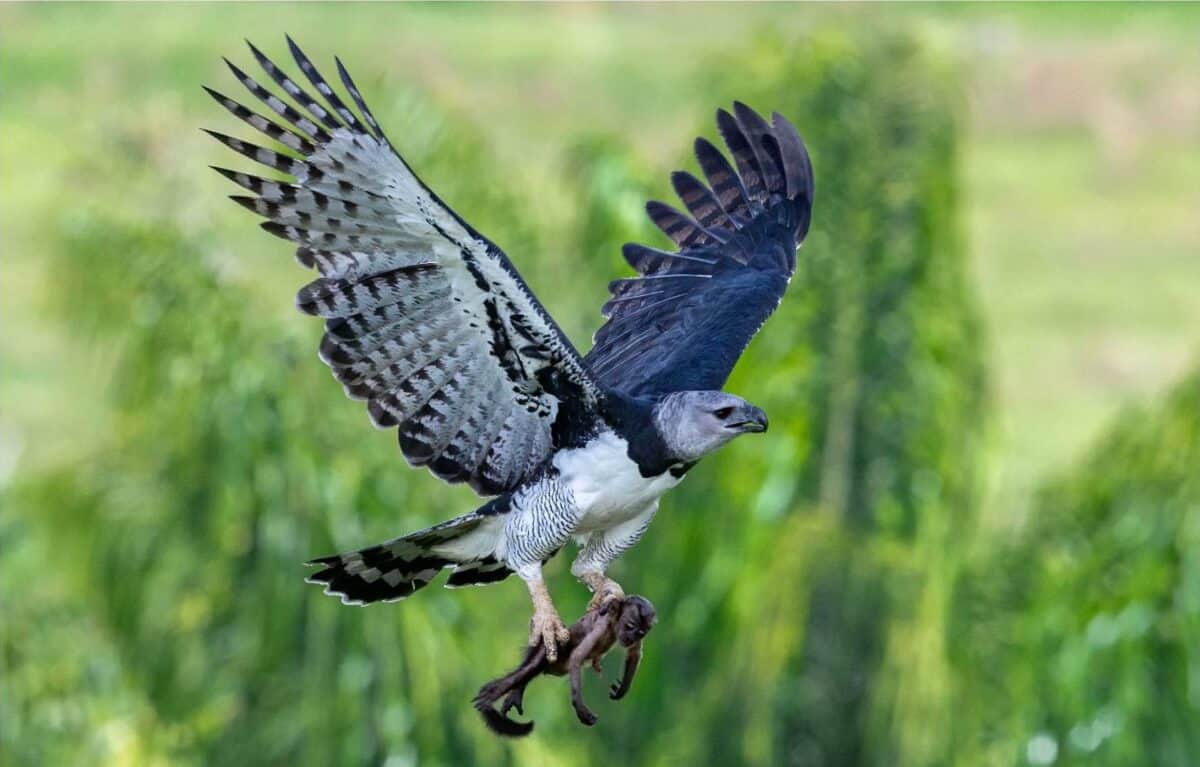
The Harpy Eagle (Harpia harpyja) is one of the most powerful birds of prey in the Amazon forest and the world. Its impressive wingspan, sharp talons, and keen eyesight make it a formidable predator in the region. This eagle preys on medium-sized mammals such as sloths and monkeys (as depicted above). Unfortunately, this eagle faces threats from habitat destruction and deforestation.
2. Scarlet Macaw (Ara macao)
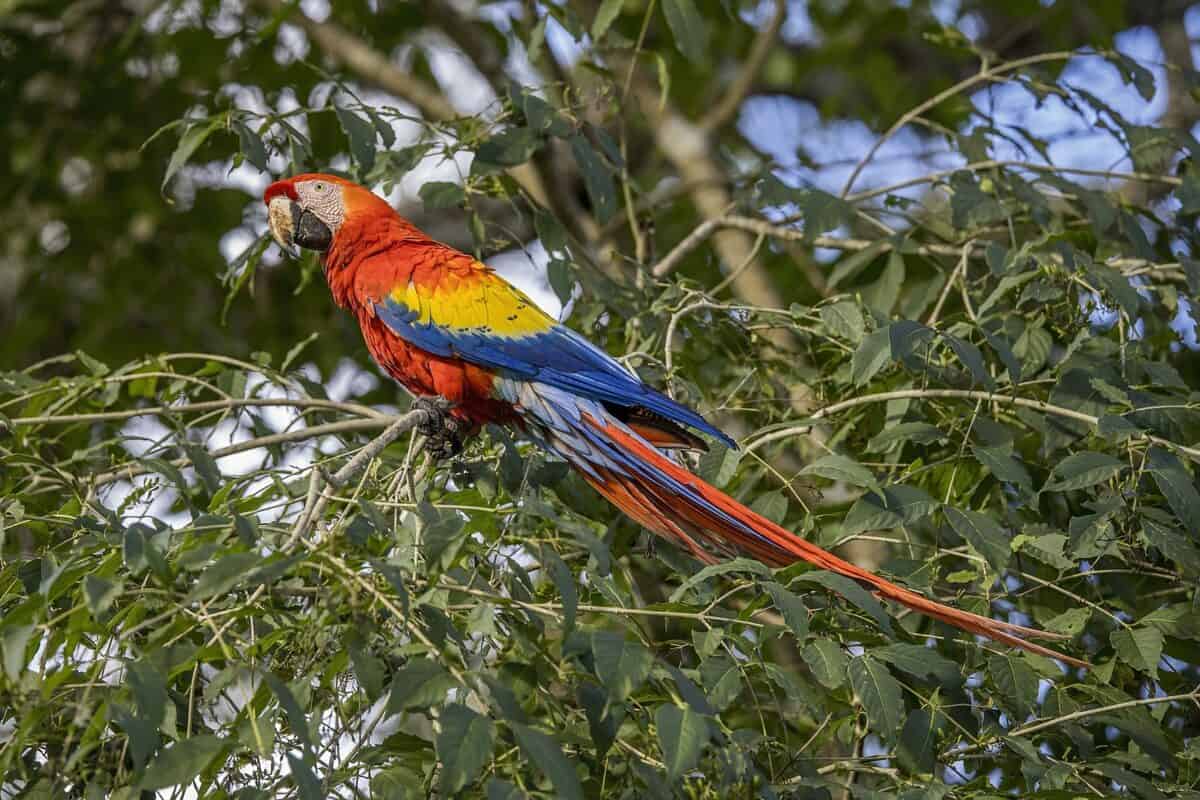
The Scarlet Macaw (Ara Macao) is one of the most colorful inhabitants of the Amazon jungle, with its vivid red, yellow, and blue plumage. Scarlet Macaws are known for their strong, monogamous pair bonds and are often seen flying or perched together in pairs. They play a crucial ecological role as seed dispersants since they feed on various fruits and nuts. Habitat loss also significantly affects their populations. Additionally, these birds are highly sought after because of their beautiful coloration, thus their populations are threatened by the illegal pet trade.
3. Hoatzin (Opisthocomus hoazin)
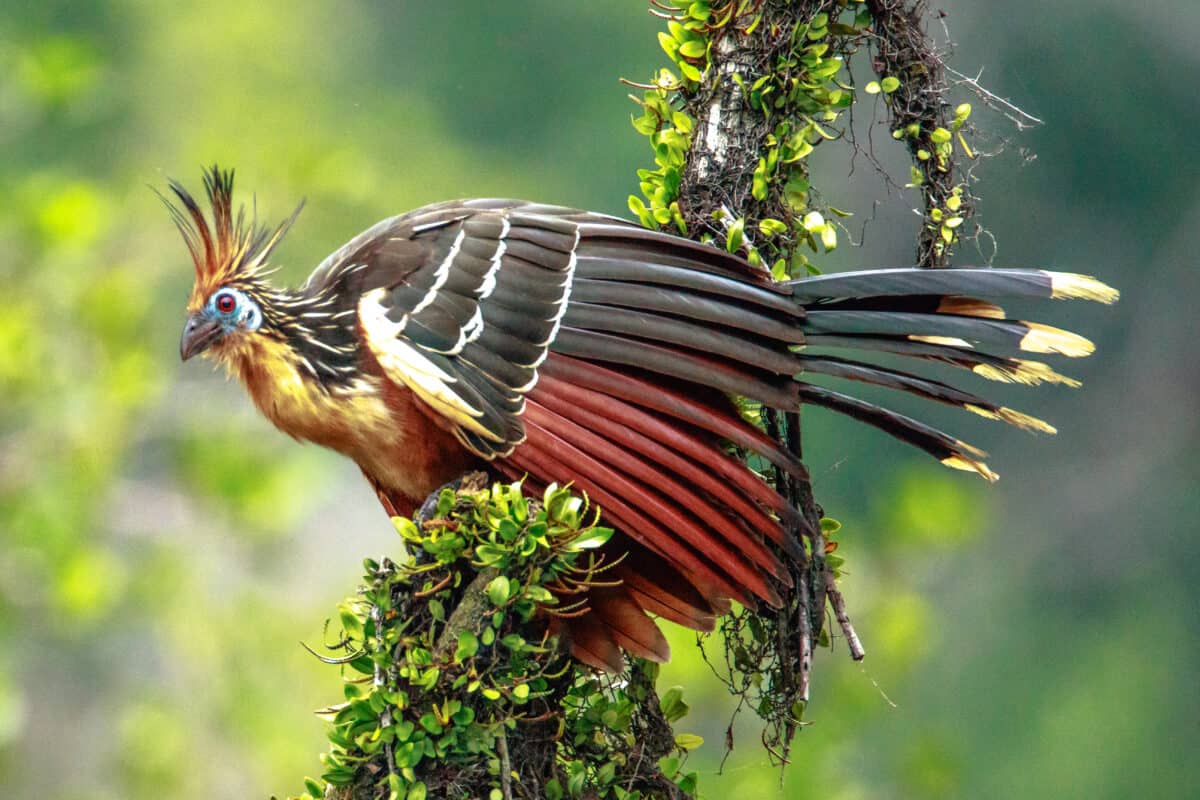
The Hoatzin (Opisthocomus hoazin)is often called the “stinkbird” due to its unique fermentative digestive system emitting an odor reminiscent of manure. This unusual digestion method is rare among birds and contributes to its distinct smell. Young Hoatzins are equipped with clawed wings, a remarkable adaptation that allows them to climb back into their nests if they fall into the water, a feature that fades as they mature.
4. Amazon Kingfisher (Chloroceryle amazona)
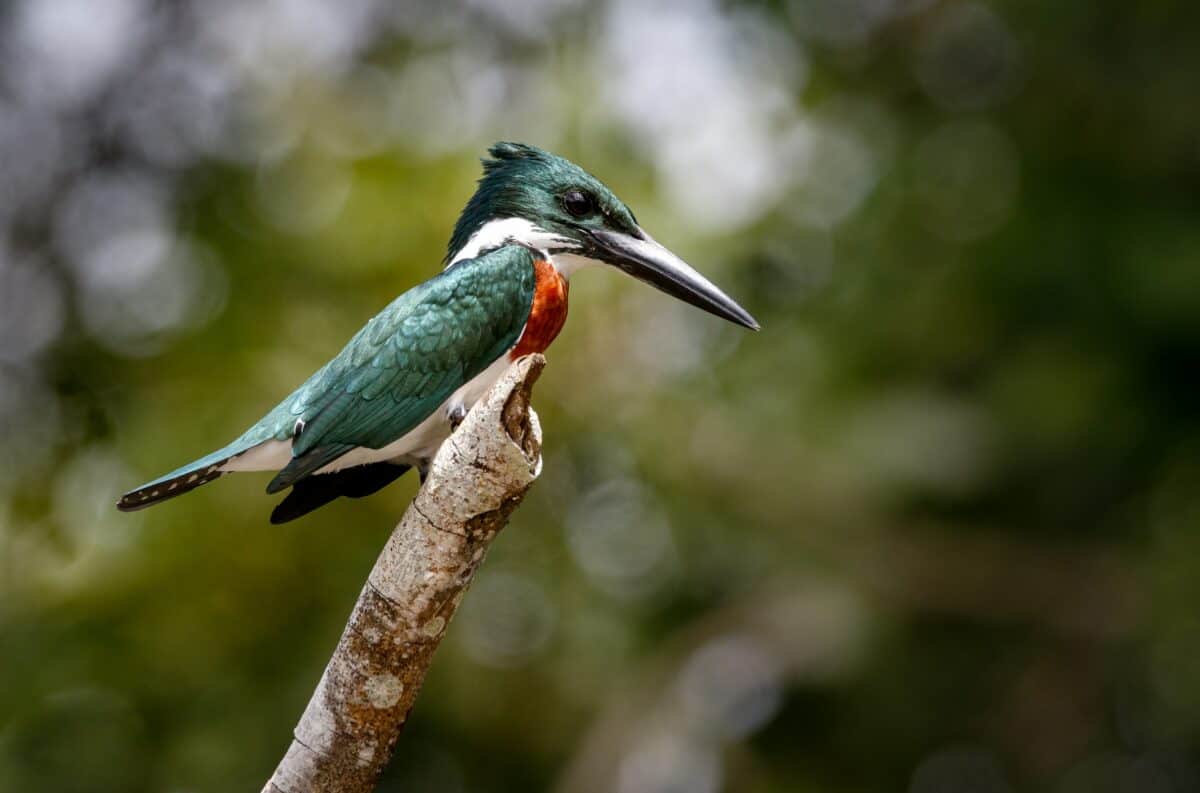
The Amazon Kingfisher (Chloroceryle amazona) grabs one’s attention with its striking green plumage long bill. This hunter is often spotted perched quietly over rivers and streams with its eyes fixed on the water below for any sign of fish. The Amazon Kingfisher, like its kingfisher cousins, exhibits sexual dimorphism.
5. Toco Toucan (Ramphastos toco)
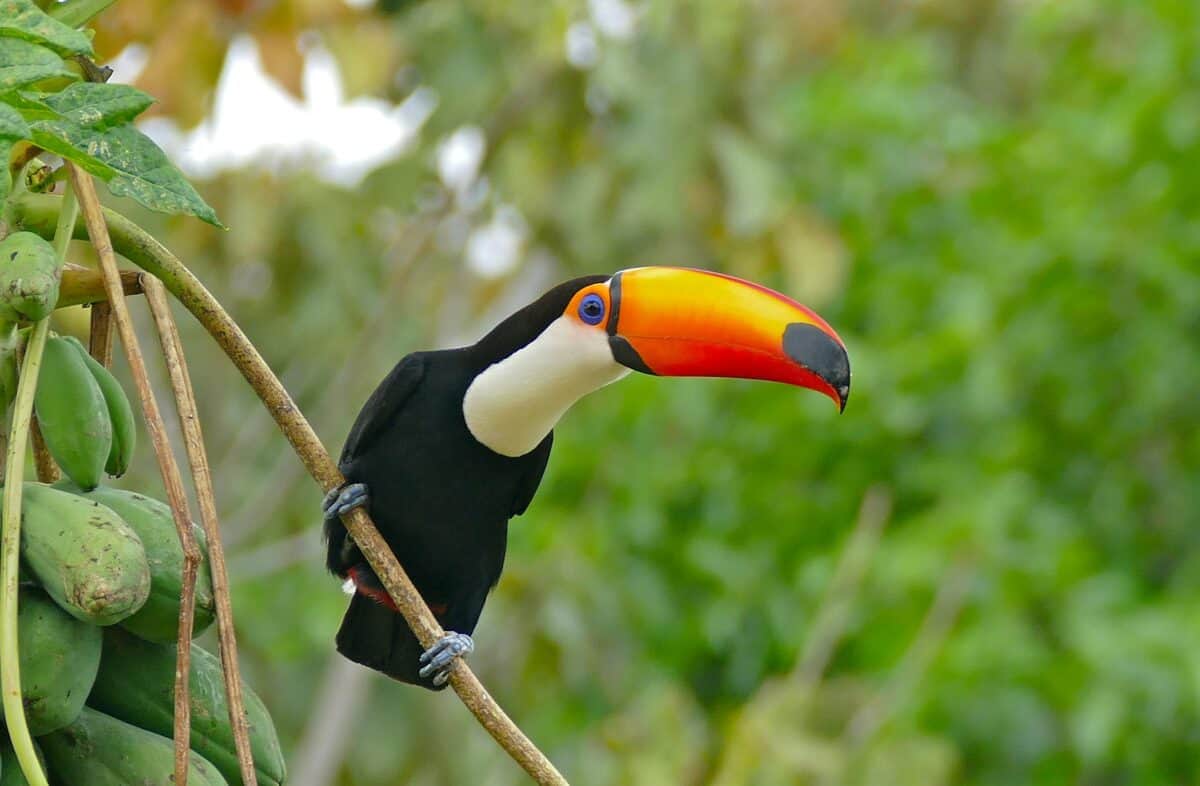
The Toco Toucan (Ramphastos toco) has an unmistakably large, colorful bill. This remarkable bill can grow to half the bird’s body length and is a highly effective tool for reaching fruits on distant branches. The Toco Toucan plays a crucial role in its ecosystem as a seed disperser by consuming fruits and excreting the seeds far from the parent tree.
6. Andean Cock-of-the-rock (Rupicola peruvianus)
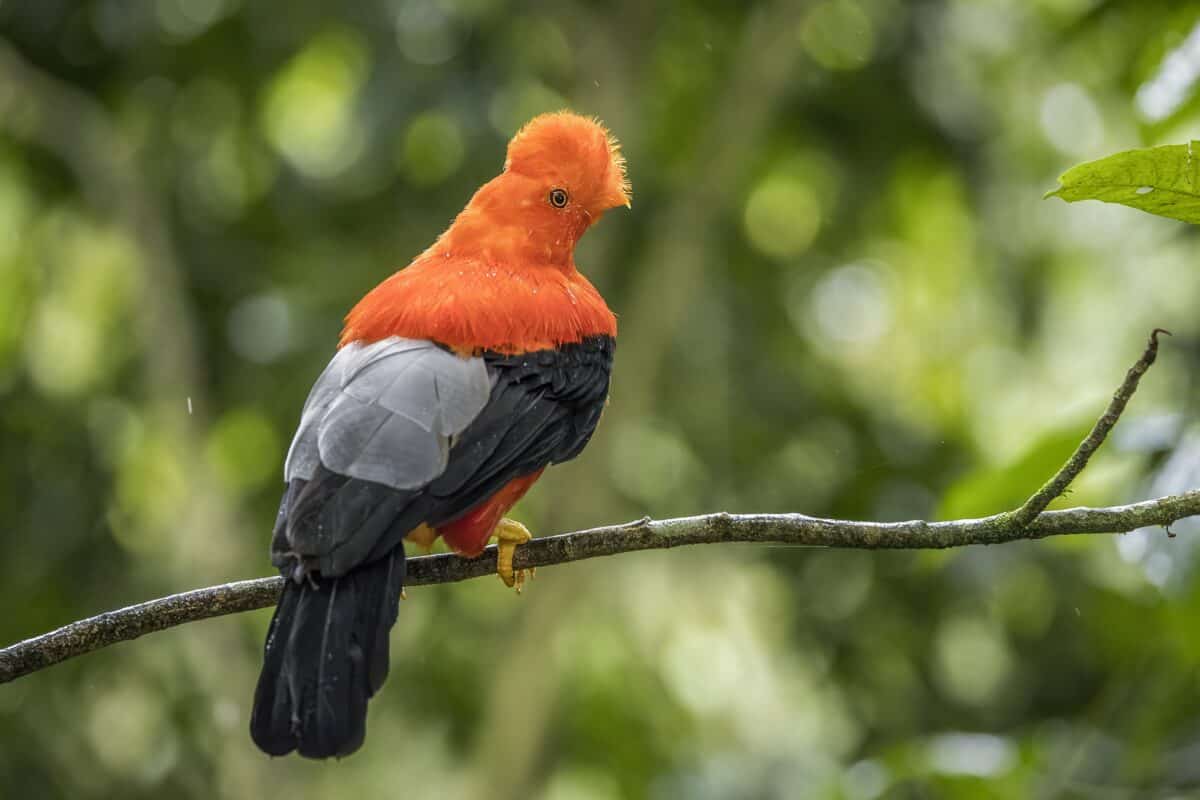
The male Andean Cock-of-the-rock (Rupicola peruvianus) bird has a bright orange plumage. While females are more subdued in color with their orange-brown feathers. This bird also plays an important role in distributing seeds, contributing to the forest’s regeneration.
7. Blue-and-yellow Macaw (Ara ararauna)
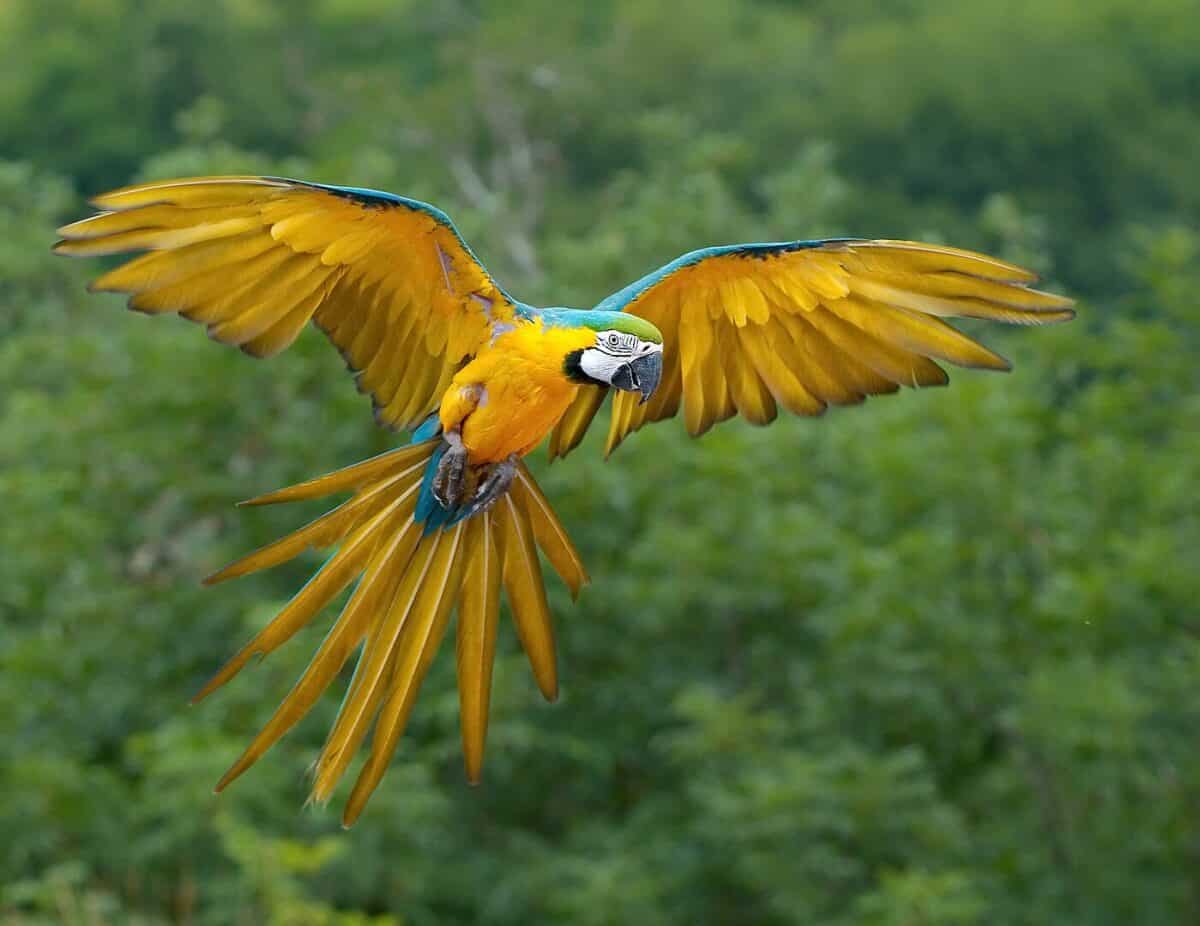
The Blue-and-yellow Macaw is a beautifully bright bird that embodies the vibrant essence of the Amazon rainforest. It is highly recognizable, making it one of the most photographed birds in the world. They are highly social and are often seen in family groups. The Blue-and-yellow Macaw birds form strong monogamous pairs.
8. Green Ibis (Mesembrinibis cayennensis)
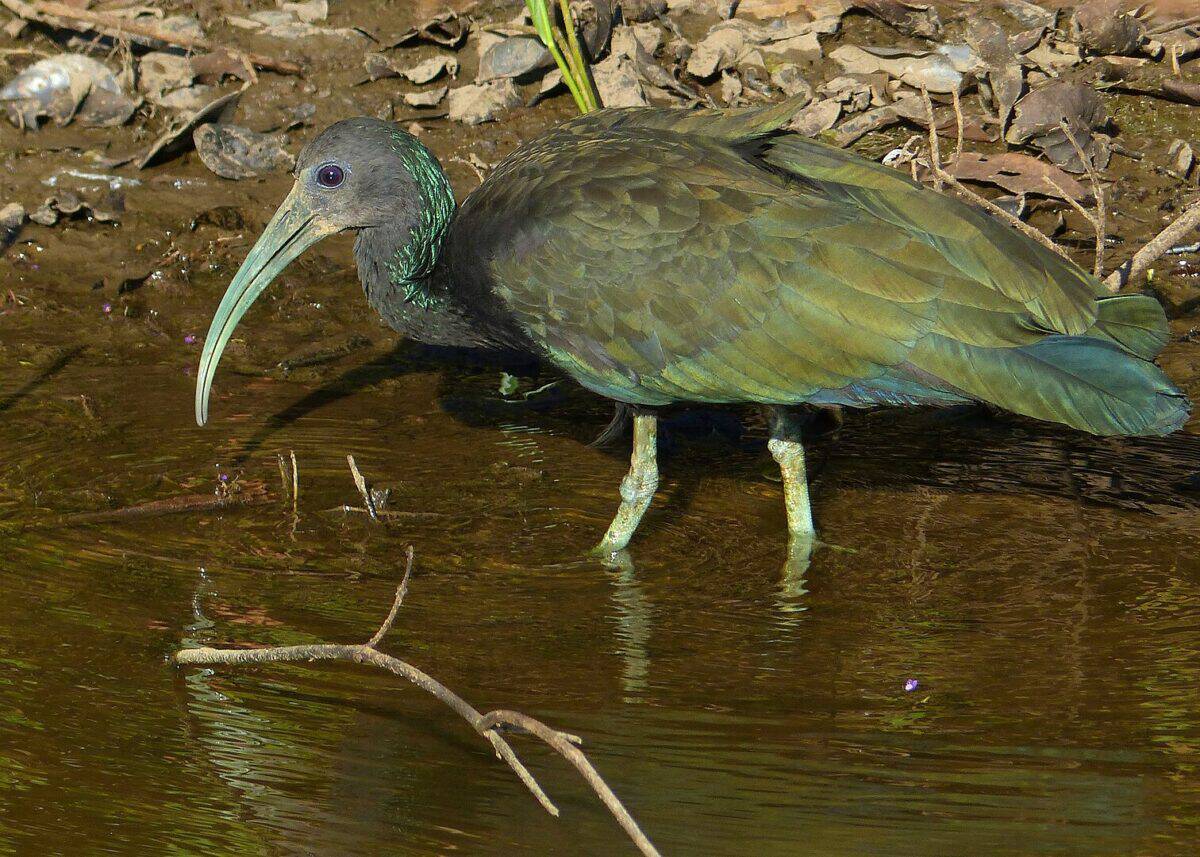
The Green Ibis is distinguished by its unique, dark greenish-black plumage that glistens with an iridescent sheen in the light. Unlike its more commonly known relatives, the Green Ibis prefers the secluded waterways and marshes where it hunts for insects, small fish, and amphibians. This bird serves as an indicator of the health of wetland ecosystems in the Amazon.
9. Festive Parrot (Amazona festive)
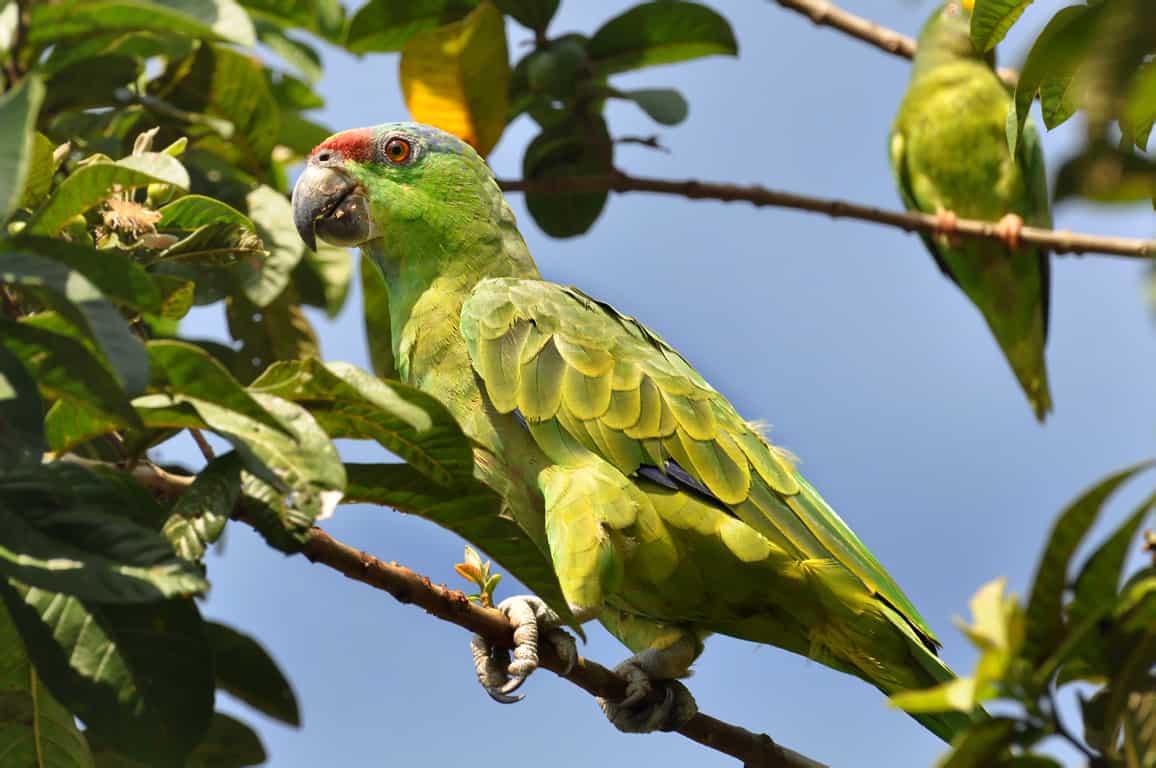
The Festive Parrot has a predominantly green plumage accented with blue and red markings. This species is known for its nomadic tendencies since they often travel in search of fruiting trees. The Festive Parrot’s diet is crucial for seed dispersal.
10. Violet-crowned Woodnymph (Thalurania colombica)
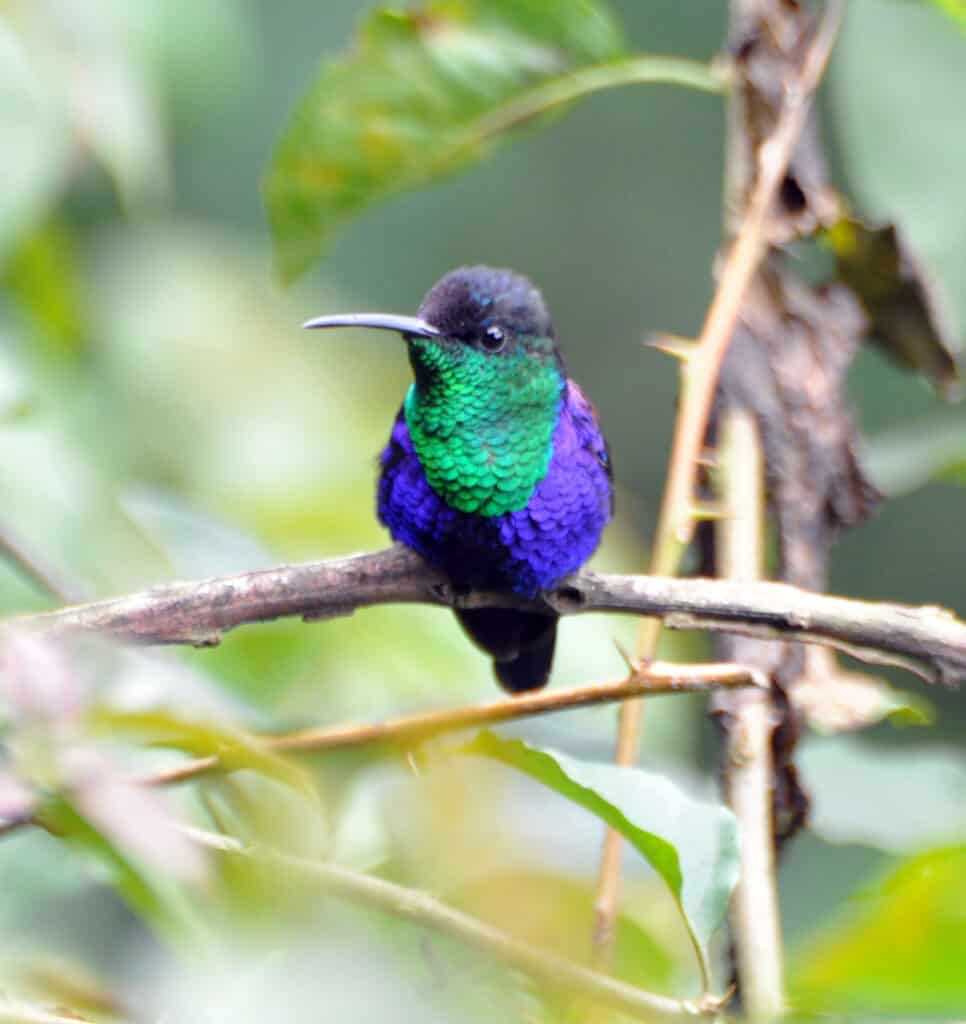
The Violet-crowned Woodnymph is a hummingbird species known for the male’s brilliant violet crown and iridescent green body. Females are less brightly colored. This tiny bird plays an important role as a pollinator. This tiny bird is found throughout Central and South America, including the fringes of the Amazon.
11. Sapphire-spangled Emerald (Amazilia lactea)
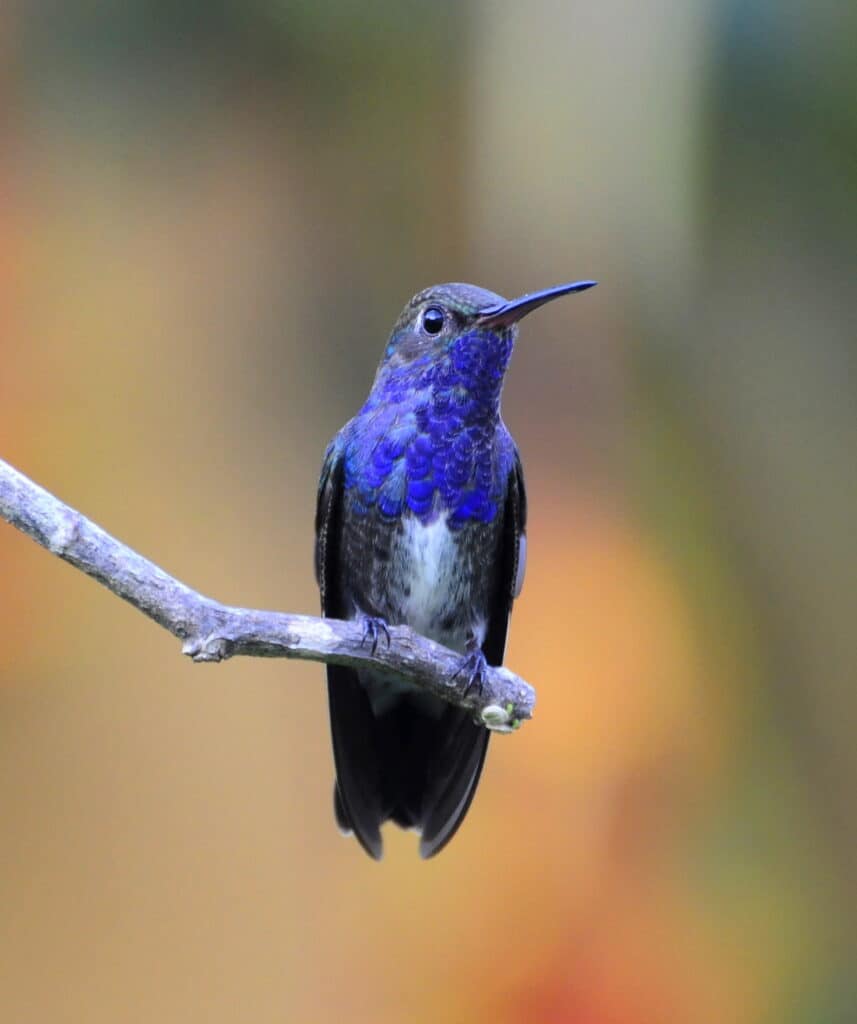
The Sapphire-spangled Emerald is a hummingbird species with iridescent green feathers and a striking sapphire-blue throat. This small bird thrives in the open woodlands and edges of forests across much of South America. Its rapid wingbeats allow it to hover in front of flowers as it feeds on nectar. This bird species also plays an important role in pollination.
12. Red-necked Aracari (Pteroglossus bitorquatus)
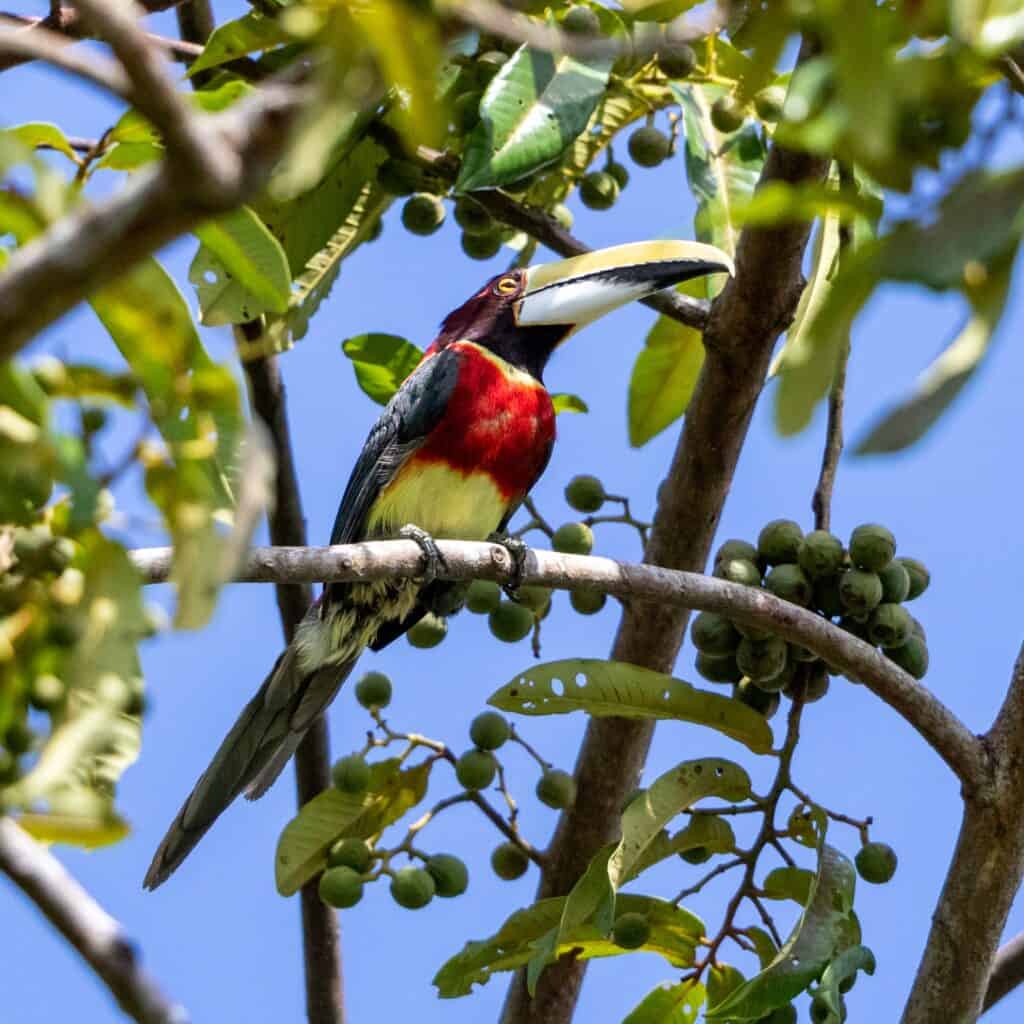
The Red-necked Aracari is easily recognized by its strikingly colorful plumage and distinctive, curved bill. This bird’s diet mainly consists of fruits, but it also consumes insects and small vertebrates. The social nature of the Red-necked Aracari is evident in its communal roosting habits.
13. Black-collared Hawk (Busarellus nigricollis)
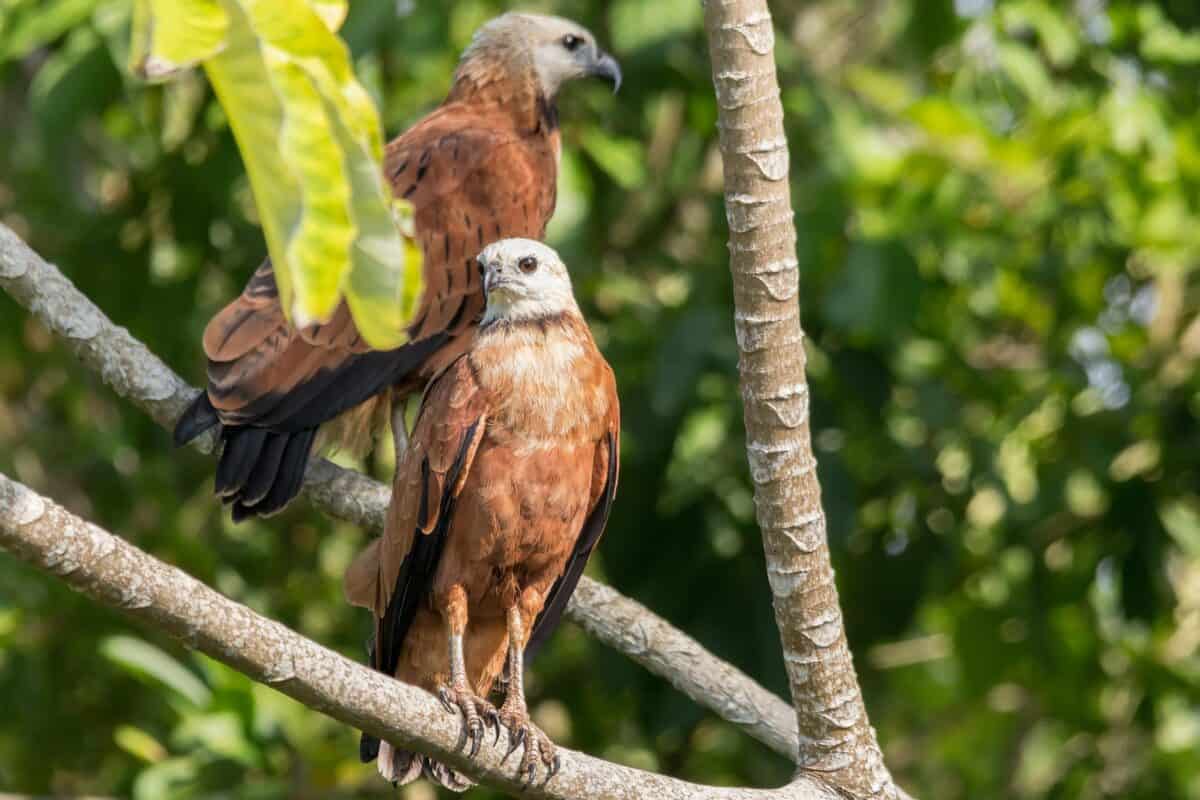
The Black-collared Hawk is an adept fisher and is often seen perched near the water with its sharp talons before diving to catch fish.
14. Hyacinth Macaw (Anodorhynchus hyacinthinus)
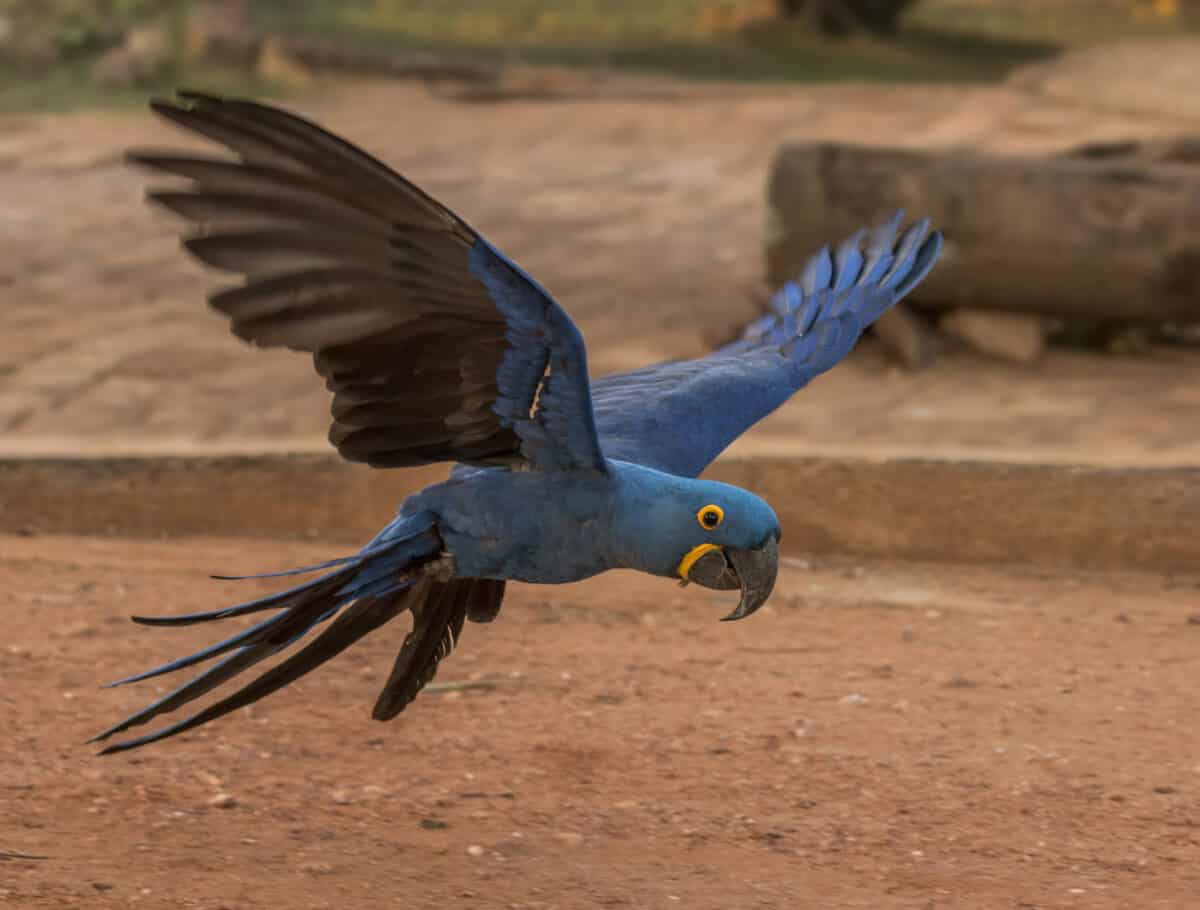
The Hyacinth Macaw is the largest species of flying parrot in the world. It inhabits the open areas and palm savannas of the Amazon. Unfortunately, it faces significant threats from both habitat loss and the illegal pet trade. Despite these challenges, conservation efforts have helped stabilize some populations.
15. Striated Heron (Butorides striata)
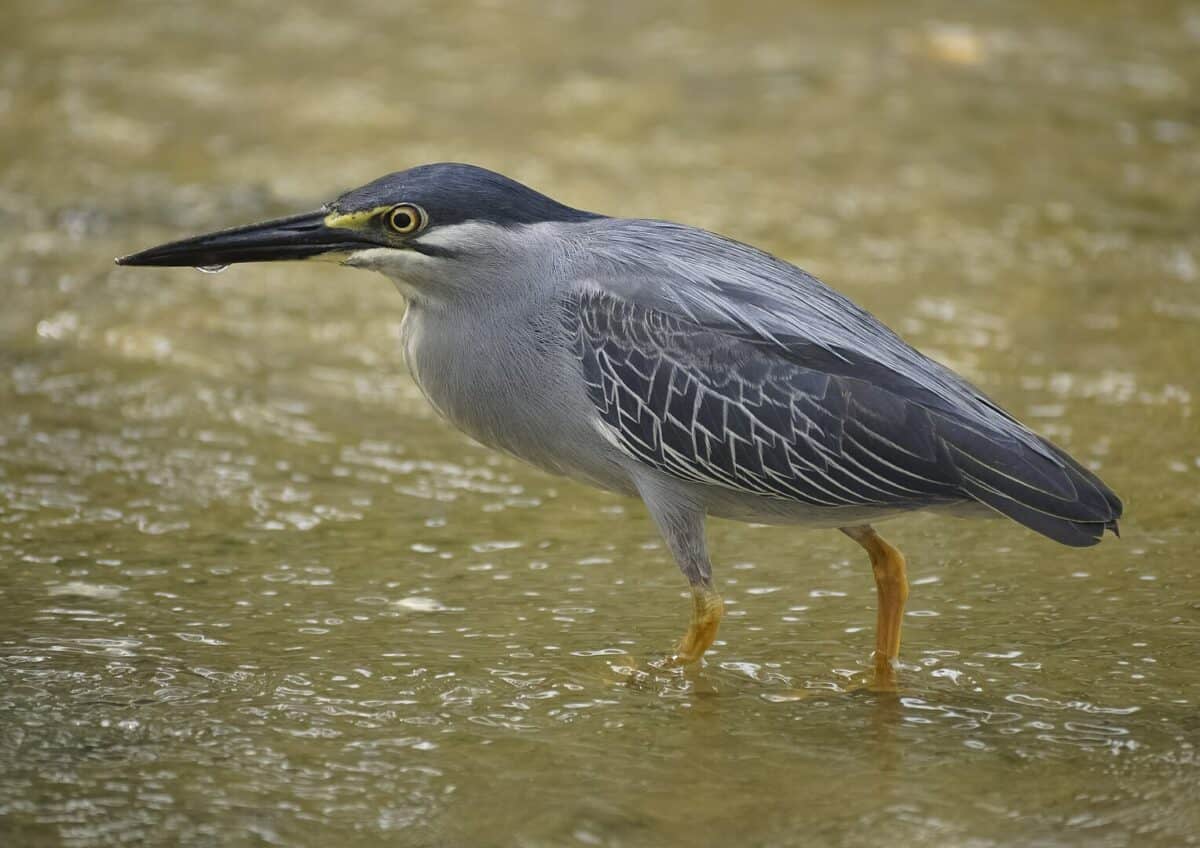
The Striated Heron (Butorides striata) is also known as the mangrove heron or little heron. This bird inhabits wetland environments across tropical and subtropical regions worldwide, including the Amazon Basin. It is often seen standing motionless at the water’s edge or perched on a low branch where it waits patiently to catch a fish with its sharp bill. The Striated Heron is highly intelligent and sometimes uses bait to lure fish within striking distance.
16. Yellow-billed Tern (Sternula superciliaris)
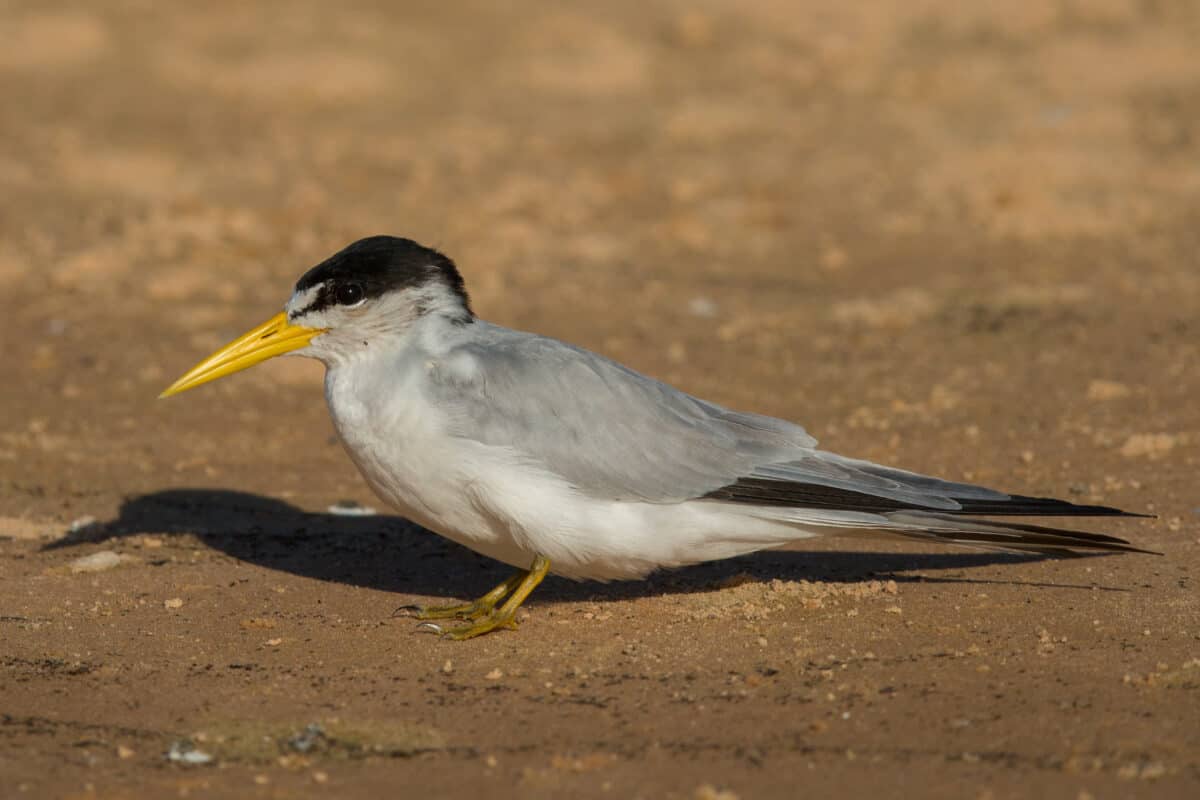
The Yellow-billed Tern is a small, agile bird found near river systems in the Amazon. Its sleek body and sharp wings allow for swift movement over water surfaces as it dives to catch fish.
17. White-throated Toucan (Ramphastos tucanus)
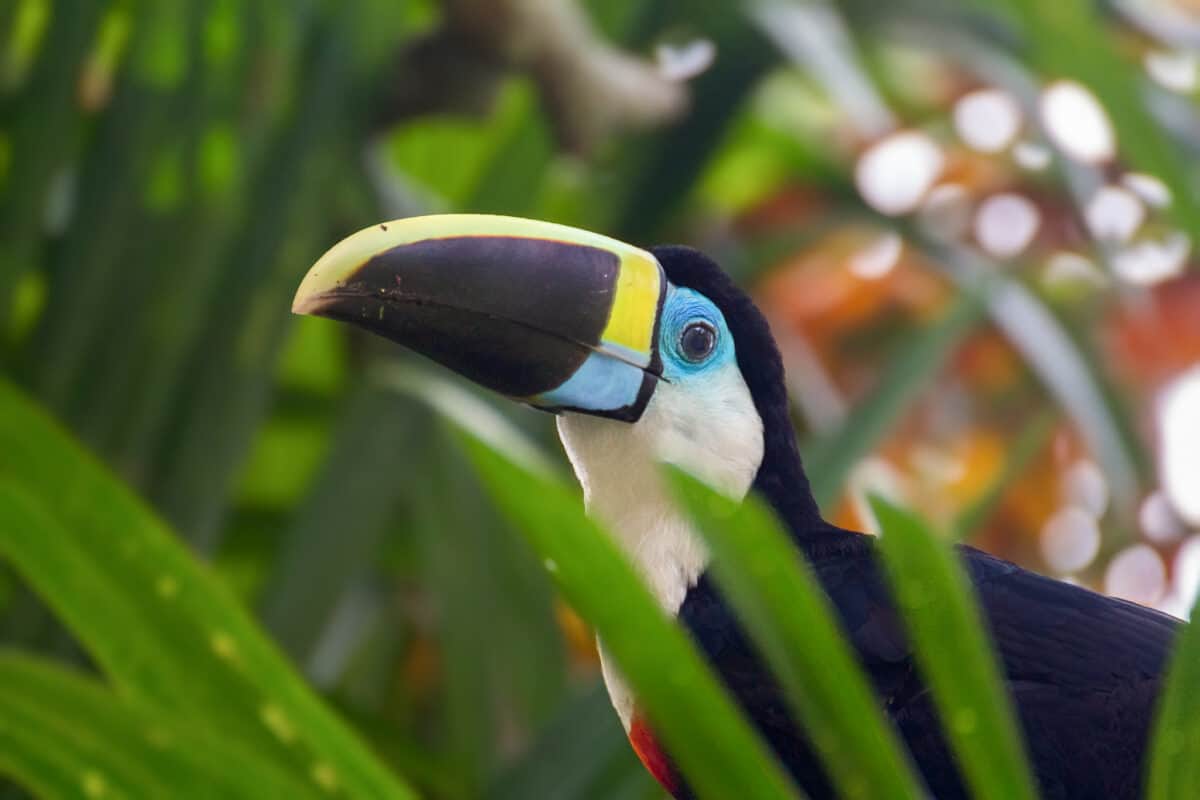
The White-throated Toucan has a large bill and striking black-and-white plumage. This social bird’s loud calls echos through the forest. It plays a vital role in seed dispersal and contributes to the health and regeneration of the forest.
18. Plum-throated Cotinga (Cotinga maynana)
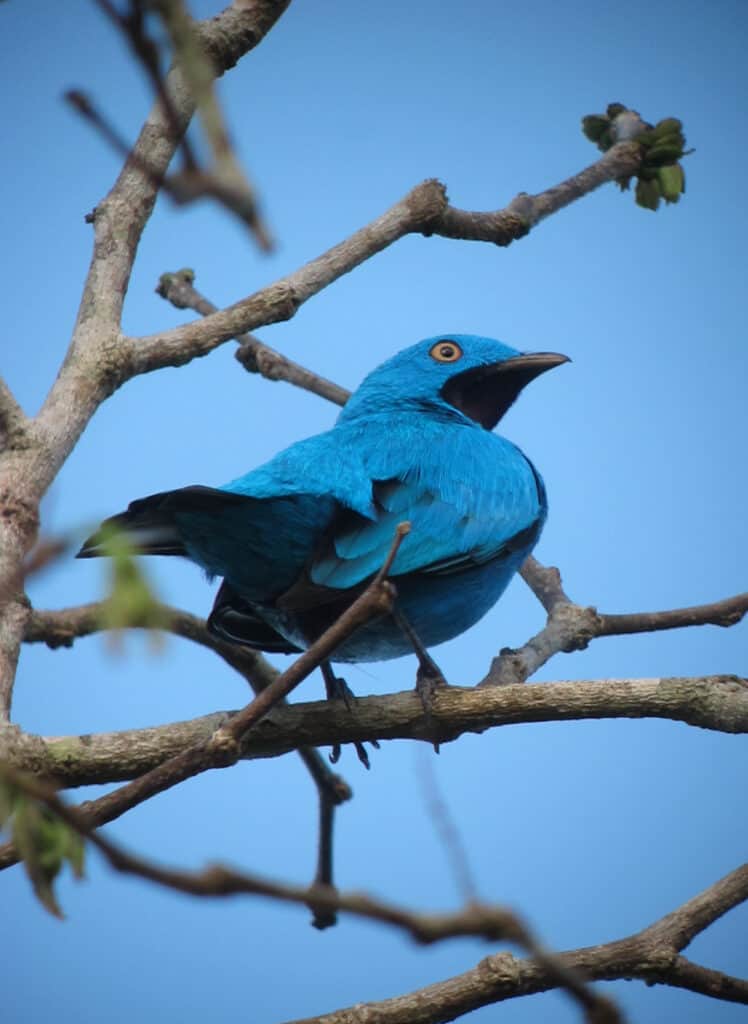
The Plum-throated Cotinga has a vivid plum-colored throat and deep blue body. This bird feeds on fruits and plays a role in the ecosystem as a seed disperser. The striking appearance and secretive nature of the Plum-throated Cotinga captivate birdwatchers.
19. Wire-tailed Manakin (Pipra filicauda)
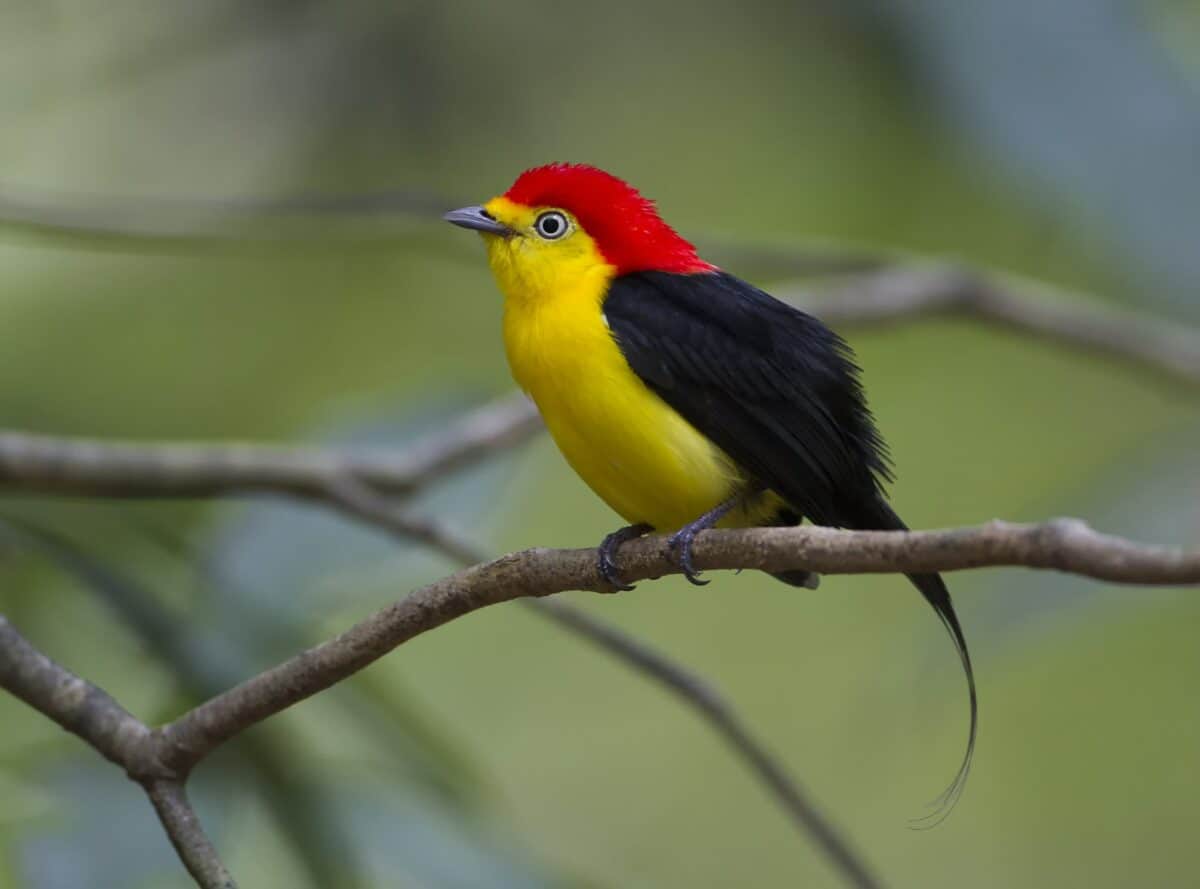
The male Wire-tailed Manakin has a vibrant yellow body and elongated, wire-like tail feathers. It is found in the understory of the Amazon rainforest. Males are known to perform intricate dances to attract females.
20. Purple-throated Fruitcrow (Querula purpurata)
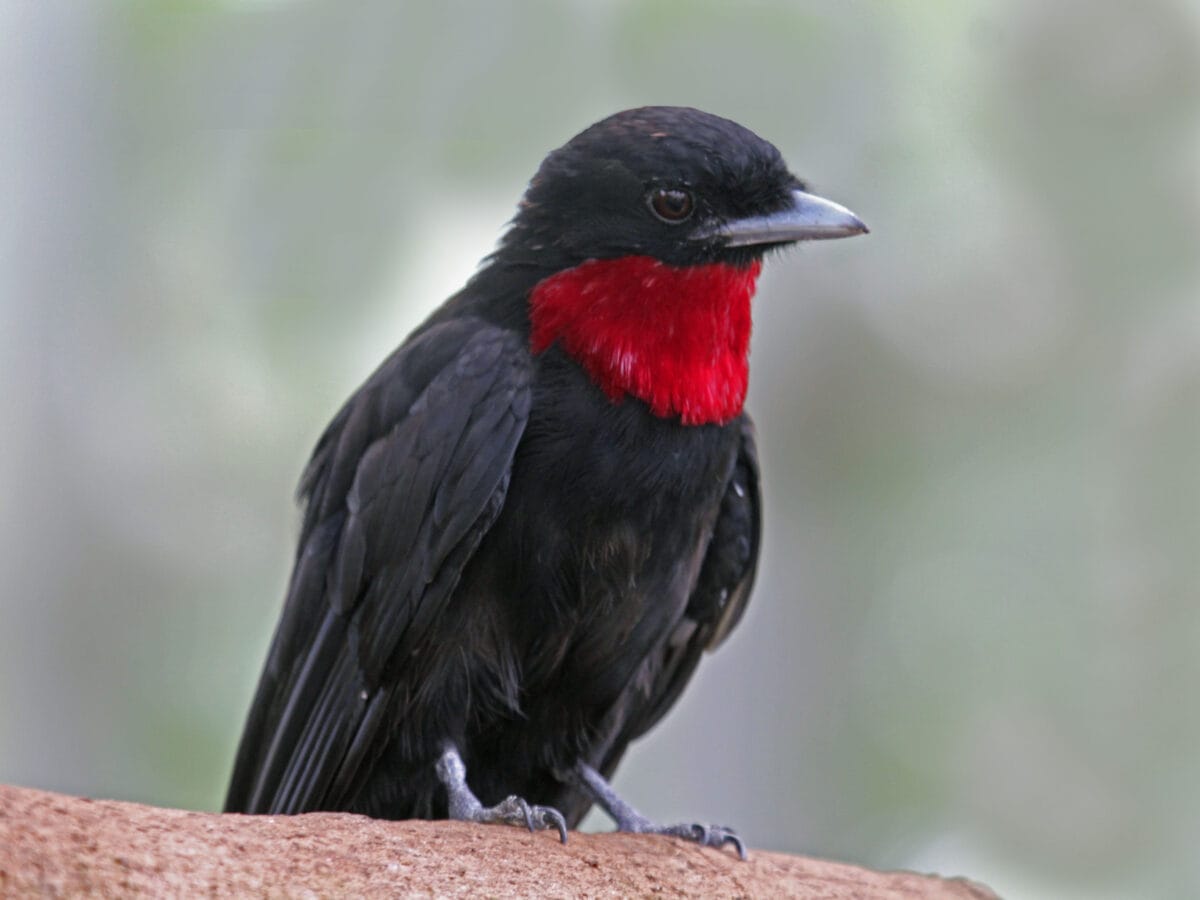
The Purple-throated Fruitcrow (Querula purpurata) is found in the dense canopies of the Amazon Rainforest and other tropical forests across South America. This species is highly sociable, often seen in small groups moving through the treetops in search of fruits. These birds play a crucial role in their ecosystem as seed dispersers, helping maintain their rainforest home’s health and diversity.
21. Crested Eagle (Morphnus guianensis)
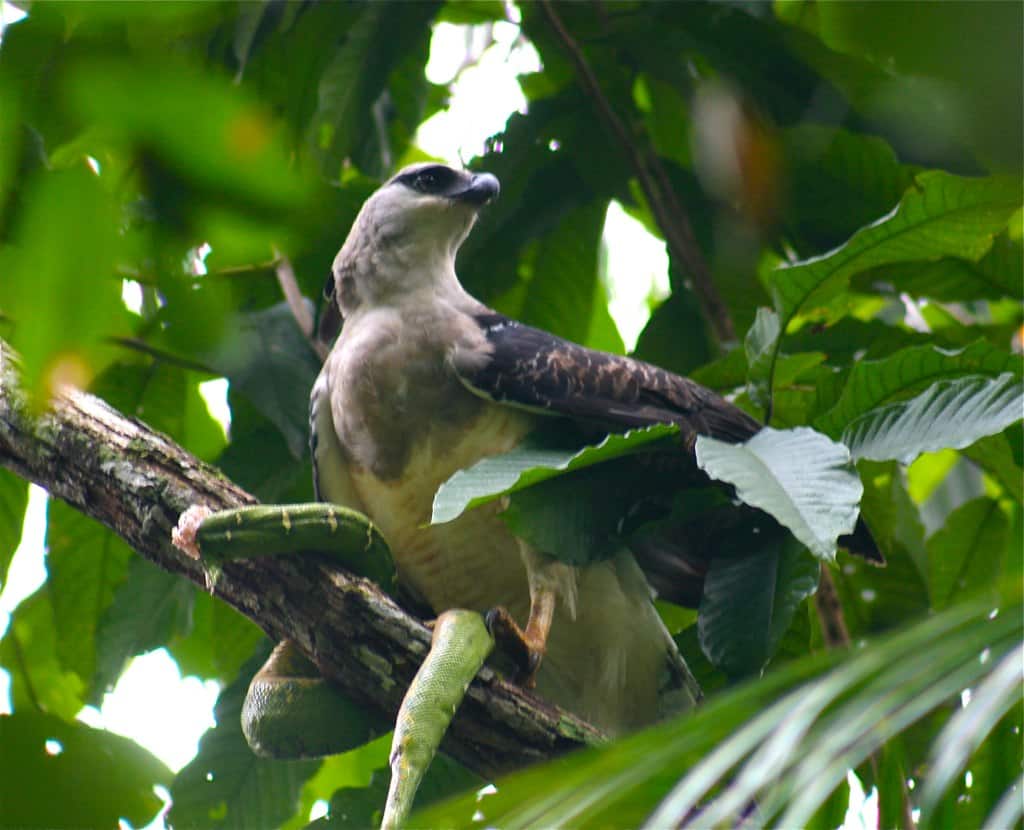
The Crested Eagle is a predator distinguished by its large size. It specializes in hunting mammals and other birds within the dense canopy. The Crested Eagle plays a role in maintaining the ecological balance of its habitat. Despite its power and presence, this eagle is elusive.
22. Red-and-green Macaw (Ara chloropterus)
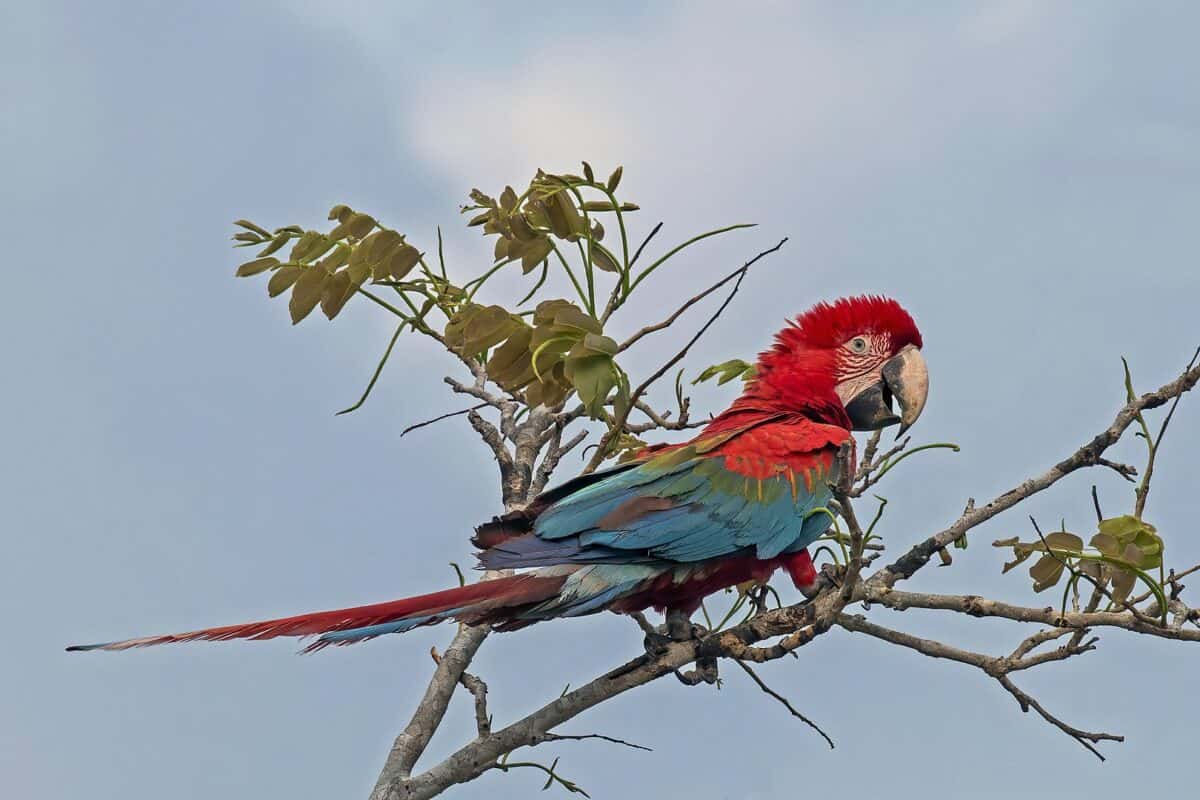
The Red-and-green Macaw is a breathtaking sight with its vibrant plumage combining red, green, and blue shades. These birds form strong paired bonds. Their loud calls and playful behaviors testify to their intelligence and social complexity.
23. Sunbittern (Eurypyga helias)
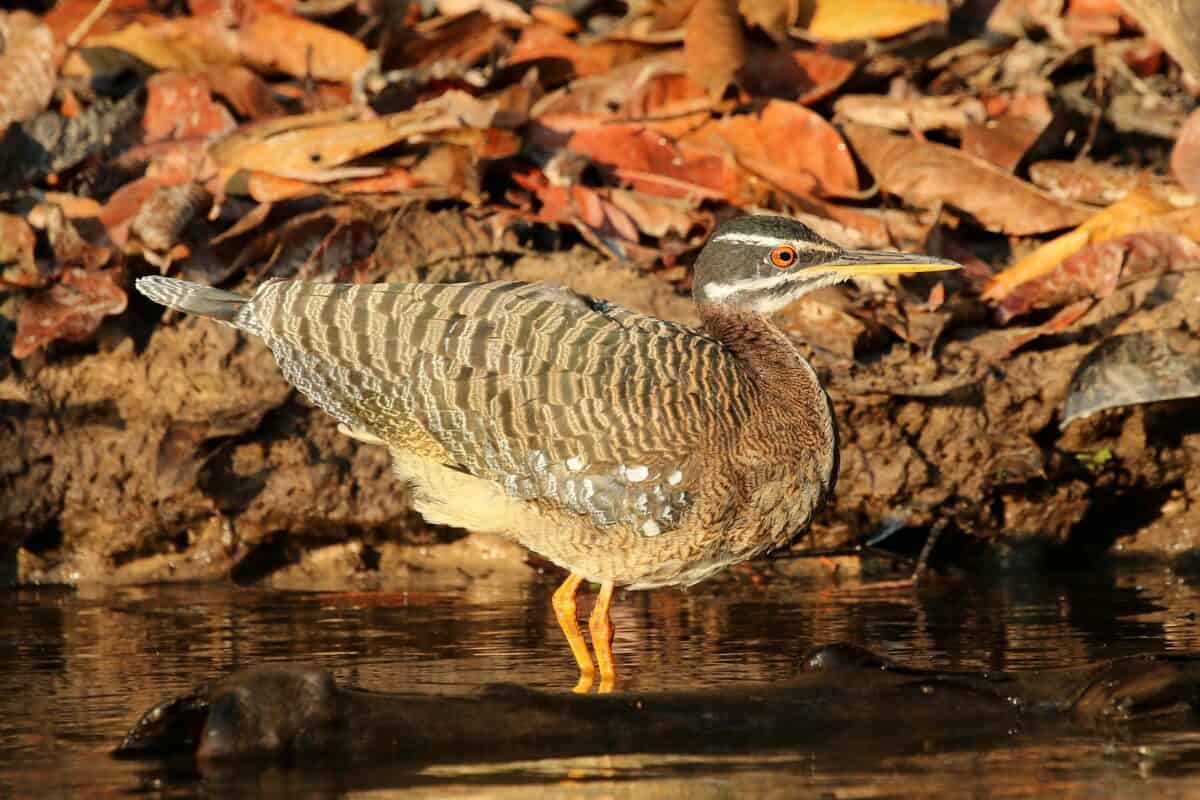
The Sunbittern is a unique bird found along the streams and rivers of Central and South America.
24. Amazonian Umbrellabird (Cephalopterus ornatus)
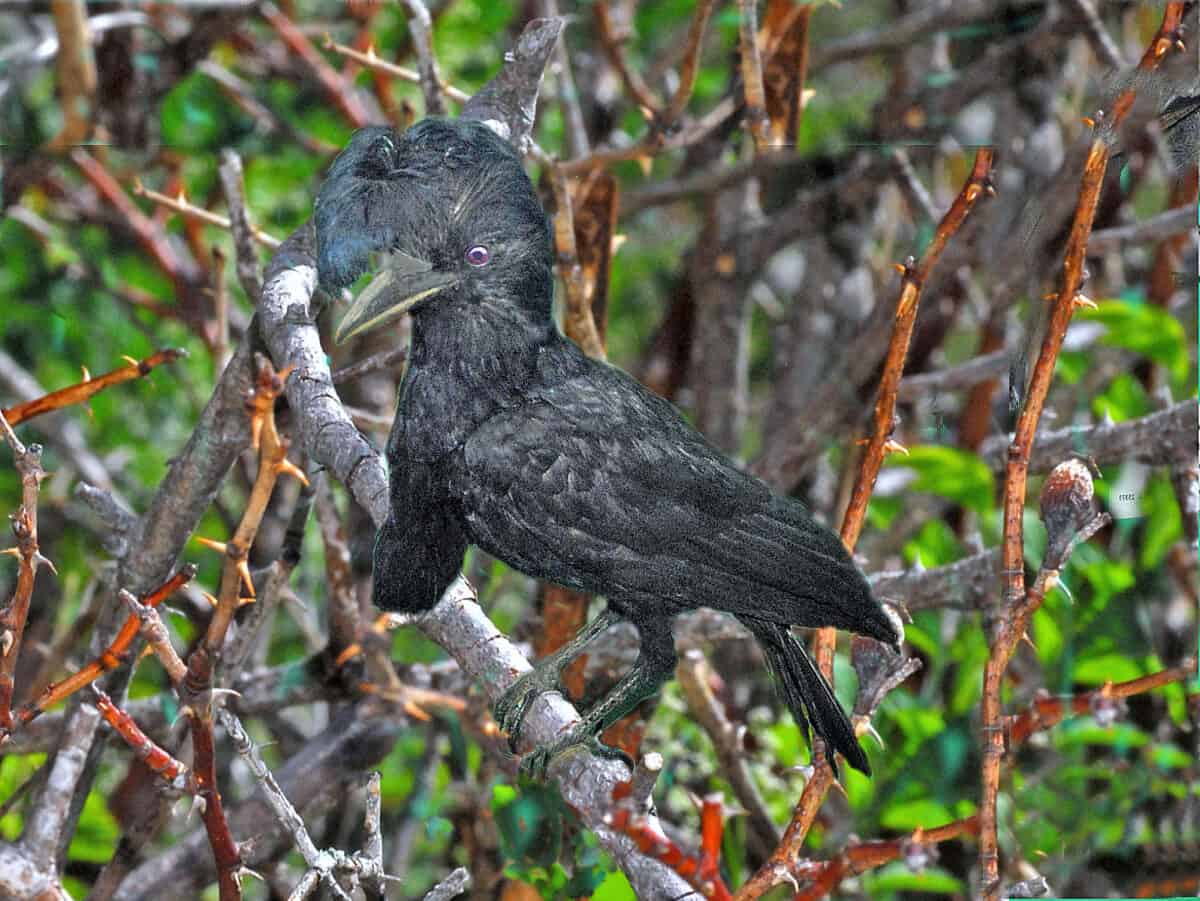
The Amazonian Umbrellabirdis is easily recognized by its large size, black plumage, and distinctive umbrella-like crest on its head. The Umbrellabird plays a vital role in seed dispersal, contributing to the regeneration and health of its environment.
25. Green-and-rufous Kingfisher (Chloroceryle inda)
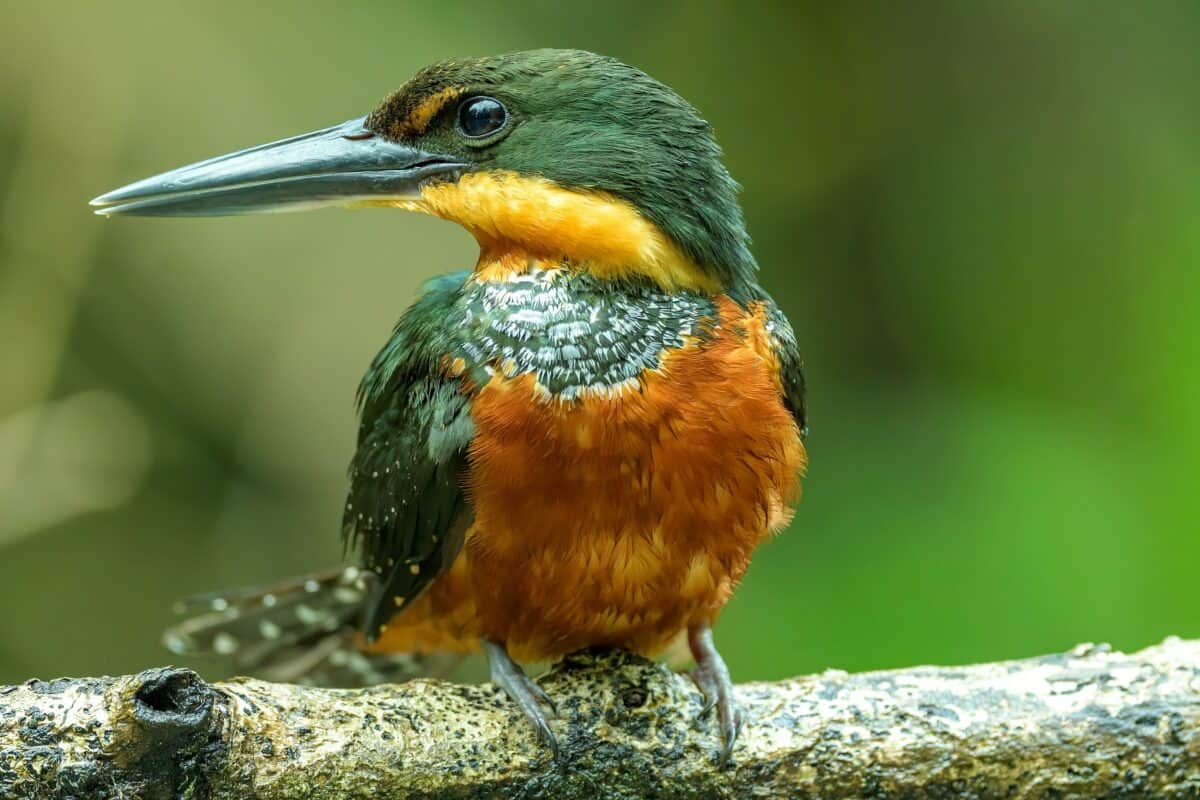
Small yet vibrant Green-and-rufous Kingfisher is a jewel of the Amazon’s waterways. It is an adept hunter capable of catching fish with great precision.
26. Pavonine Quetzal (Pharomachrus pavoninus)
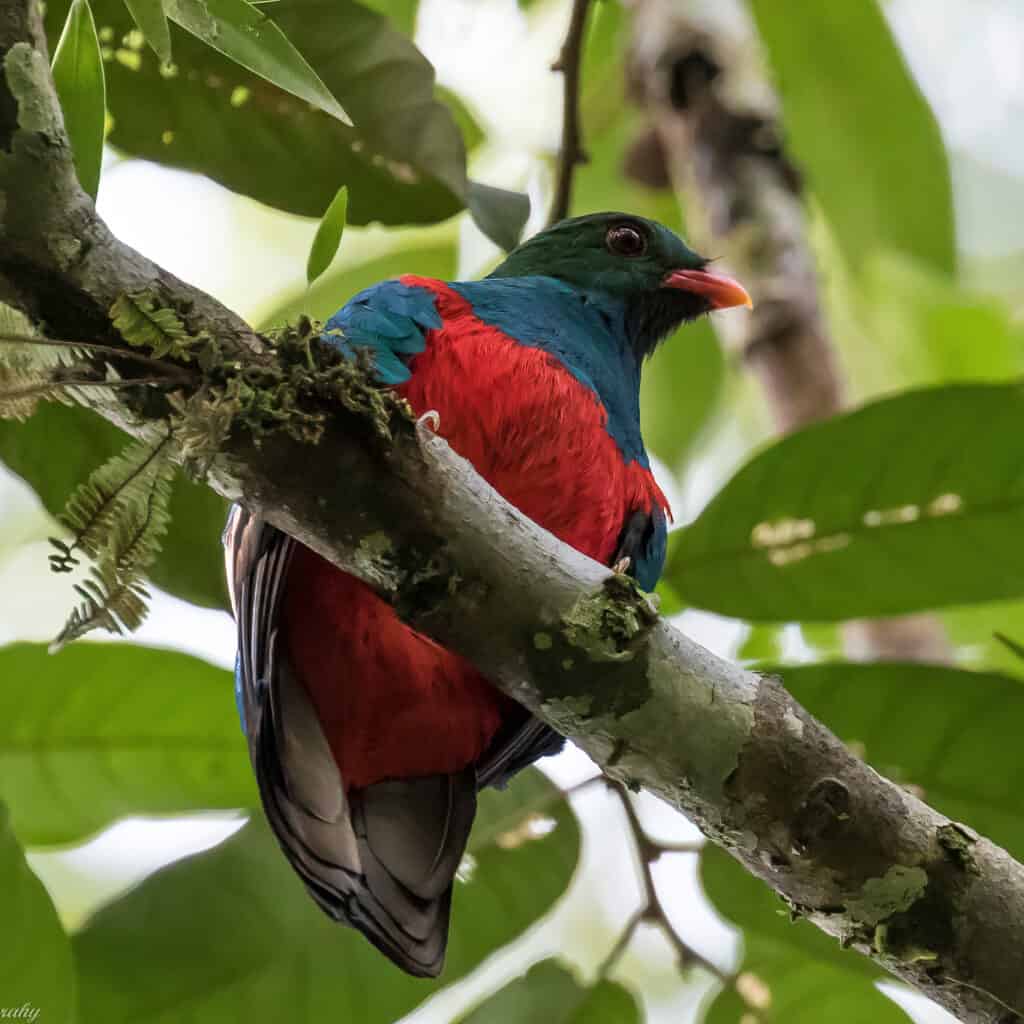
The Pavonine Quetzal has an iridescent green plumage and elegant tail feathers, which captivate all who glimpse it. This bird plays an important role in seed dispersal.
27. Golden-collared Toucanet (Selenidera reinwardtii)
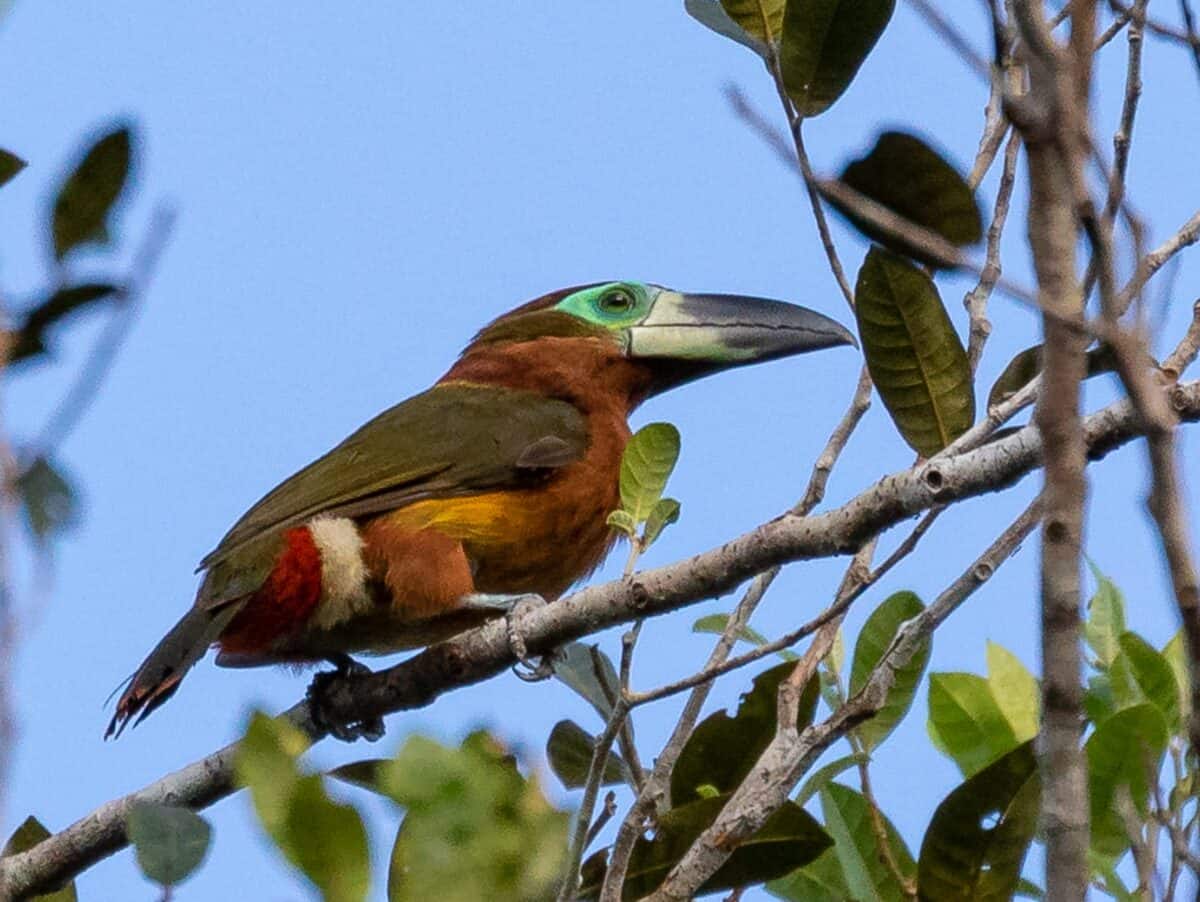
The Golden-collared Toucanet distinctive golden collar. Despite its smaller size compared to other toucans, this bird’s bright colors and lively calls contribute significantly to the vibrancy and soundscape of the rainforest.
28. Blue-throated Piping Guan (Pipile cumanensis)
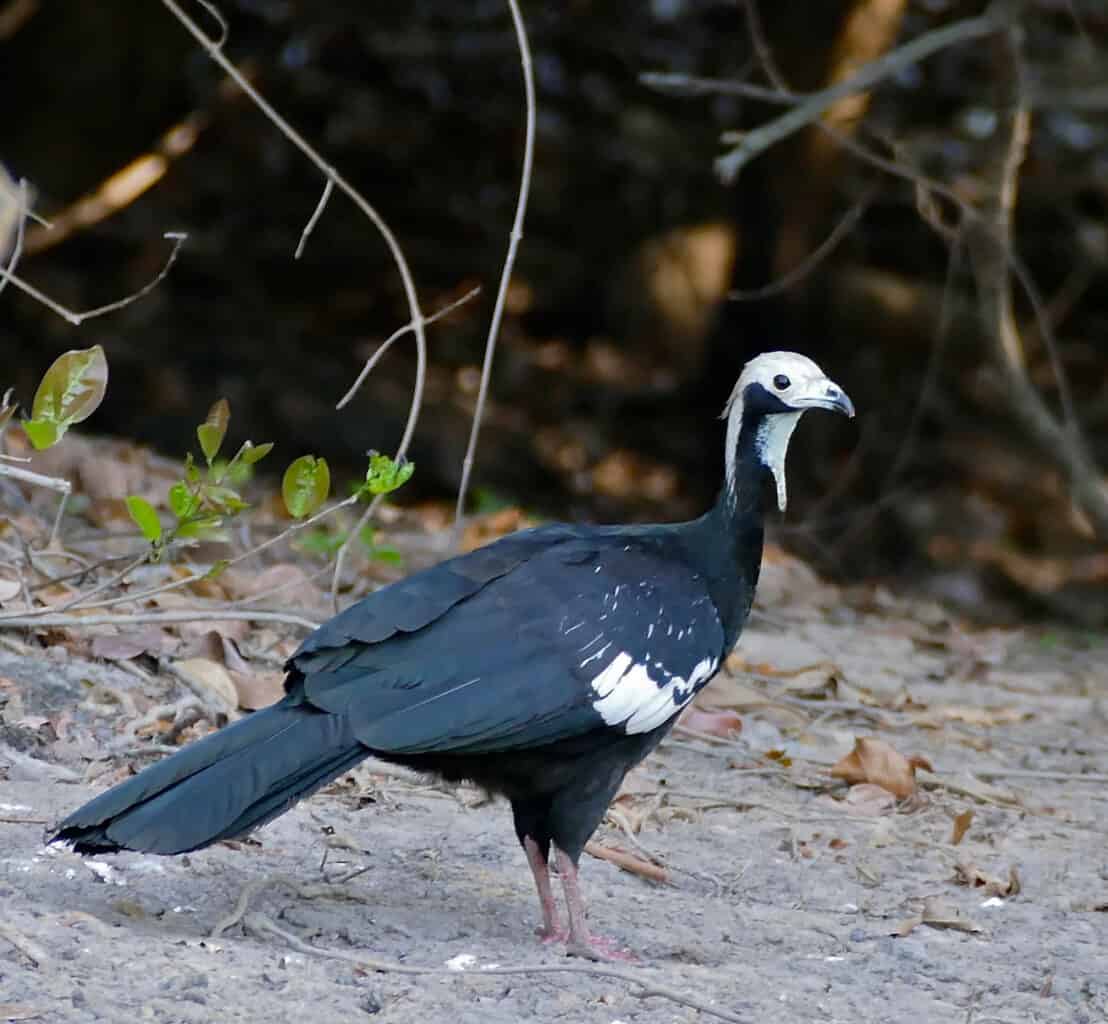
The Blue-throated Piping Guan is often heard before it’s seen with its distinctive piping calls that echo through the forest. As a frugivore, it plays a crucial role in seed dispersal, contributing to the health of its rainforest habitat.
29. Snow-capped Manakin (Lepidothrix nattereri)
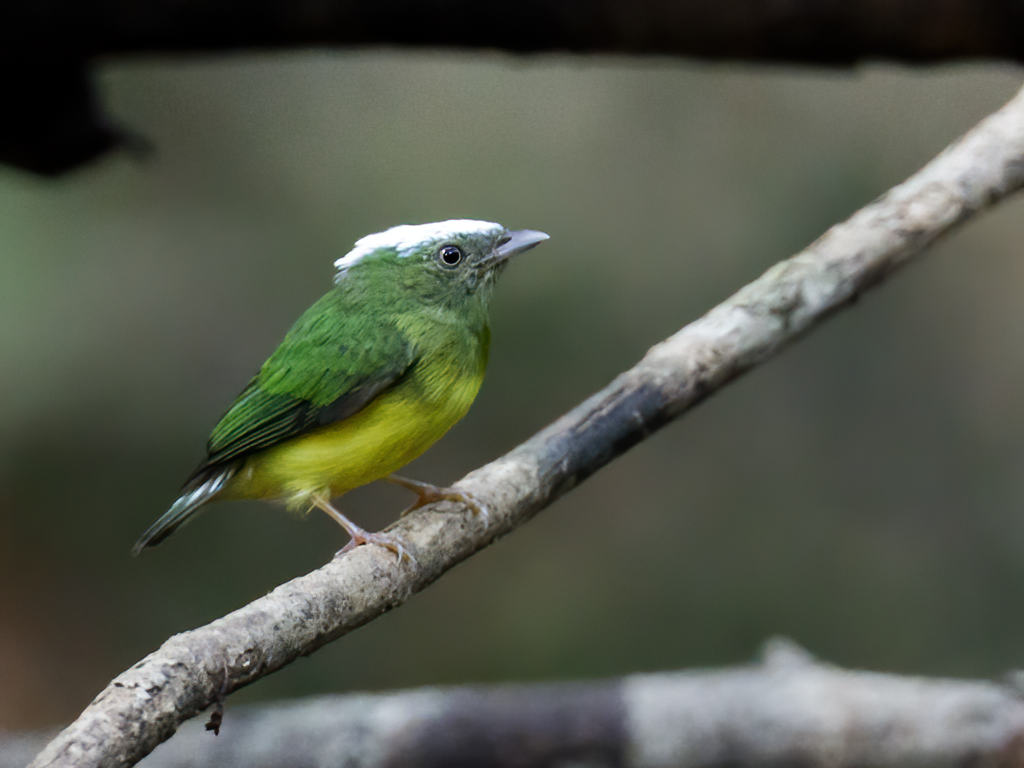
The Snow-capped Manakin is a dazzling bird known for its white cap. This bird is renowned for their elaborate mating dances.
30. Long-billed Woodcreeper (Nasica longirostris)
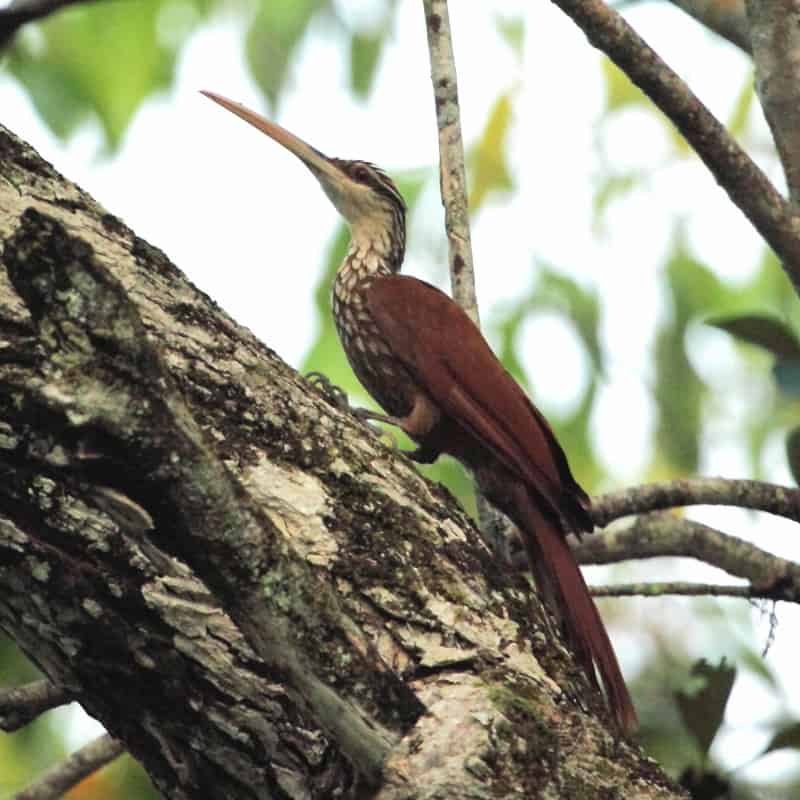
The Long-billed Woodcreeper stands out with its remarkably elongated bill, adapted perfectly for extracting insects from bark and crevices.
Each bird species plays an important role in the Amazon rainforest. Their conservation is vital to maintaining ecological balance.
You might also enjoy:
Bald Eagle Vs. Andean Condor: Two Majestic Birds Of Prey
Watch: A Baby Elephant Play with Birds
Migratory Birds Use Earth’s Magnetic Field as an Aid to Navigation
Join our Forum for free today!

- The Bond Between a Wild Baby Bison and Her Rescuer - July 20, 2024
- An Excited Husky’s First Ever Time in Snow - July 20, 2024
- Top 20 Colorful Species To Brighten Your Day - July 14, 2024
